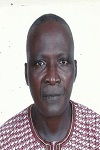Day 1 :
Keynote Forum
Lars Linsen
Professor, Westfälische Wilhelms-Universität Münster, Germany
Keynote: Visual Analysis of Spatio-temporal Simulation Ensembles
Time : 10:00-10:35

Biography:
Lars Linsen is a Full Professor (W3) of Computer Science at the Westfälische Wilhelms-Universität Münster, Germany, at the Institute of Computer Science. He is also an Adjunct Professor of Computational Science and Computer Science at the Department of Computer Science and Electrical Engineering of the Jacobs University, Bremen, Germany. He received his academic degrees from the Universität Karlsruhe (TH), Germany, including a diploma (M.Sc.) in Computer Science in 1997 and a PhD in Computer Science in 2001. He spent three years as a post-doctoral researcher and lecturer at the Institute for Data Analysis and Visualization (IDAV) and the Department of Computer Science of the University of California, Davis, U.S.A. He joined the Department of Mathematics and Computer Science of the Ernst-Moritz-Arndt-Universität Greifswald, Germany, as an assistant professor in 2004. In 2006, he joined Jacobs University as an associate professor and became a full professor in 2012. In 2017, he moved to his current affiliation, the Westfälische Wilhelms-Universität Münster, Germany. His research interests are mainly in the areas of data visualization or interactive visual data analysis and include certain topics in computer graphics and geometric modelling.
Abstract:
Mathematical models are used for the description and the understanding of phenomena in all sciences. Numerical simulations support the validation of the models and data assimilation purposes. For computer animations, spatio-temporal simulations are used to derive the appearance of natural phenomena. These simulations often depend on a number of simulation parameters and initial configurations. The selection of these parameters and configurations is often not exactly known or their impact is part of the underlying research tasks. Therefore, multiple simulation runs with varying parameter settings or ensembles of simulations with varying configurations are executed. The analysis of such simulation ensembles is complex, especially when each simulation run represents a four-dimensional spatio-temporal phenomenon. The amount of data of a simulation ensemble often adds up to hundreds of Gigabytes or even Terabytes. The analysis of such complex data is no longer possible without the use of computers. On the other hand, such an analysis typically requires the expertise of a human. For animations, the designer would need to find the simulation run with the desired appearance. As visual representations are intuitive and can be processed efficiently by humans, it is a suitable approach to combine visual representations and interaction mechanisms with automatic analysis steps.
In this talk, I will present novel visualization methods that allow for an interactive comparative analysis of such large and complex data stemming from spatio-temporal simulation ensembles.









































 n the National Scholarship in 2010 and won the National Endeavor Fellowship in 2009. She received a master graduate in Computer Application Technology in Shijiazhuang Tiedao University in 2015. She published many papers including ISTP, EI and SCI and participate in the National Natural Science Fund Project. From 2015 she is in the school of software engineering, Department of information, Beijing University of Technology, completing her PhD. Her research interests are the Internet of things and software engineering and Embedded and image and video quality assessment.
n the National Scholarship in 2010 and won the National Endeavor Fellowship in 2009. She received a master graduate in Computer Application Technology in Shijiazhuang Tiedao University in 2015. She published many papers including ISTP, EI and SCI and participate in the National Natural Science Fund Project. From 2015 she is in the school of software engineering, Department of information, Beijing University of Technology, completing her PhD. Her research interests are the Internet of things and software engineering and Embedded and image and video quality assessment.








































